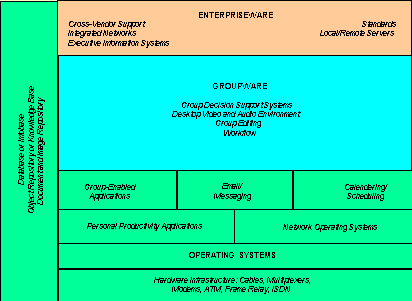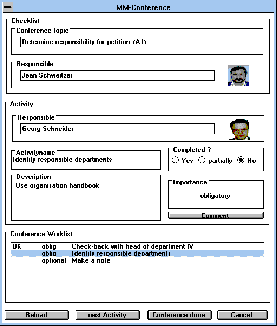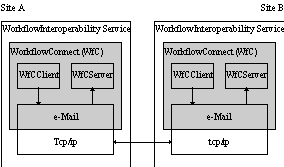First steps from workflow management systems towards
Enterpriseware
Georg Schneider, Heiko Maus
Clemens Dietel, Astrid Scheller-Houy, Dr. Jean Schweitzer
Abstract
Workflow management systems are an effective means of guaranteeing a high
quality in the execution of business processes and services. Furthermore,
they enable the establishment of telework places which are gaining more
and more importance in the competitive business environment. Despite the
obvious advantages, there are still some obstacles which will have to be
overcome to make distributed working a real success. One of the major drawbacks
of the existing systems is that they have no means of supporting synchronous
co-operative work e.g. by using multimedia desktop conference systems.
Another shortcoming is that only first steps have been done to establish
interfaces between workflow management systems. As a consequence, it is
hardly possible to execute one coherent workflow using different workflow
management systems. The integration of control data for other applications
like conference relevant information has not been taken into account. In
this contribution we present some concepts which lead the way to more developed,
intelligent, distributed assistant systems which will be able to comprehensively
support co-operative work.
We aim at the interoperability of hetrogenuous applications into an
enterprise and over enterprise borders, to establish a service which optimal
supports work in an virtual enterprise (see fig. 1).

Fig. 1: Architecture of enterpriseware [Cole95]
The concepts described are based on the work from the project WoTel
of the Siemens AG (developed with other major companies and the German
Telekom) and from the project Polivest, from SNI AG and Siemens AG with
the German Ministry for Research.
Integration of synchronous co-operative work
Workflow management systems can only support more or less sequent tasks
what we call asynchronous telecooperation. They proceed on the assumption
that work can be divided into steps so that every step can be handled with
the results of the former steps and knowledge of the current employee.
They also presume that no mistakes have been done earlier in this chain.
Unfortunately in daily work there are many violations on these assumptions.
Finally today's workflow management systems do not take into consideration
that even well structured operations include often tasks that strongly
influence each other because the nature of the tasks is interrelated, concurrent
or informal. These processes could not be captured by a workflow management
system. The use of Multimedia Collaboration (MMC) Conference systems can
contribute to eliminate these drawbacks, since they allow to work together
in teams on specific topics, directly from the desktop without leaving
once place. This mode of operation we call synchronous telecooperation.
Additionally the integration of MMC Conference systems into workflow management
systems allows to contact managers, other workflow participants or the
system support group without lengthy interruptions.
Another advantage of MMC Conferences is the reduction of media breaks
which inevitably occur when a workflow participant leaves his place to
join a "normal" conference.
Distinctive Characteristics of Multimedia Conferences
In the workflow context, basically MMC Conferences can be differentiated
by the following aspects (see also [SSS 96], [SMDSS 96]):
-
Moment of Modeling
-
Coordination of the Conference
Moment of Modeling
Considering the time when the conference is modeled we can distinct two
instants. Conferences that are already planned at the moment of the development
of the workflow are called pre-scheduled conferences.
In contrast to that the occurrence of an ad-hoc conference is
not foreseeable at the time where the workflow is specified, e.g. because
of an unexpected problem. The point of starting a MMC Conference depends
on the actual situation. At the development time there are no information
about the conference, because at this time no conference is planned.
Coordination of the Conference
A further possibility to distinct MMC Conferences is how or by whom the
execution of the conference will be controlled and coordinated (see [RSVW94]).
If the conference is coordinated by the system it is called static conference.
If it is coordinated by a participant of the conference we call it dynamic
conference.
As static conferences are concerned the content and the way how the
conference will be executed are described in detail. The conference activities
are fixed (see also [Jabl94]). The conference has a rigid and somehow inflexible
structure. The conference activities are totally transparent to the workflow
system. Consequently the workflow can interrupt and reinvoke the conference.
In contrast to this the execution of a dynamic conference is free and
imposes no constraints on the conference participants concerning the way
how they organise their work during the conference. They are the only responsible
for the conference coordination. The content is specified by the subject
of the conference and an agenda. At the beginning of the conference the
conference activities need not to be fixed. The workflow refers to the
work on this agenda as a single process activity.
Checklist
Beside the usual applications like Word or Excel the checklist is an additional
document that will be shared during a MMC Conference. It is a tool to support
the co-ordination of conferences. As for static conferences all conference
activities are workflow activities the checklist serves only as an agenda.
Here it is only a supplementary information source for the conference participants.

Fig. 2: Checklist
Dynamic conferences need the checklist for conference coordination and
monitoring. It describes the activities for the conference like a to-do
list, which can be dynamically changed (expanded or shortened). Furthermore
the checklist is a tool to record the conference results. Figure 2 shows
how the checklist looks like. The row containing "activity state" indicates
whether all conference activities are completed. If the conference is interrupted
and continued some days later the participants know which activities have
been completed and on which activities work is required. This is necessary
because the workflow cannot support this task as he refers to the conference
as a single process activity. The row "importance" enables the conference
participants to postpone or ignore activities that do not necessarily contribute
to a successful conference result such as activities like writing a protocol.
This is a means to offer a more way to work during MMC conferences. The
"Checklist Responsible" is regarded as a conference leader. This person
undertakes the conference coordination. The concept "task responsible"
in conferences is the same than in workflow management systems. So conferences
and workflows can be analysed by a uniform evaluation mechanism. Furthermore
the checklist can be adapted to specific requirements, e.g. by introducing
timestamps for billing purposes.
Workflow-Workflow Interoperability
Since workflow management systems and their functional scopes are not standardised
until now, many different products are available. Depending on their strength
each of these different systems will be used to support specific tasks
or to satisfy the requirements of the particular companies, departments
within companies, etc.. For this reason in the future it will become a
must to have interoperability concepts to connect these different products.
A workflow will neither have to stop at enterprise borders nor will an
enterprise have to concentrate on a single product. So business and task
specific workflow frameworks will be established that exploit the advantages
of the workflow management systems used. Furthermore only these interoperabiltity
concepts make it possible to efficiently establish virtual enterprises.
Workflow Connect (WfC)
The protocol
The execution of processes over multiple workflow systems will be synchronised
by sending messages with specific protocol information (and documents)
from one workflow management system to the other over a connection and
communication service. Looking at the heterogeneity in the area of workflow
management systems the protocol must be very general to fit with all of
them. Specific information need not be transmitted. It consists of two
parts:
-
Workflow related part
-
Application specific extensions
Connection Service specific extensions
The Workflow related part of the protocol contains actions, that will
be executed on the other workflow system. Additional parameters for control
are also part of the protocol, to guarantee correct execution and addressing.
Application specific extensions:
This block is used to give the possibility to make the protocol individual
configurable and easy extendible. It will be used by applications to transfer
specific information.
Error handling
In case of an error, an error message will be send to the initiating
workflow management system with an error code.
Realisation of WfC
The realisation of the transmission of the data, the protocol etc. and
the synchronisation will be done by the WfCClient (fig. 3). The WfCClient
also includes objects like documents and sends all as a request in the
context of a session with an unique ID to the partner WfMS. The ID is used
to unique assign replies, confirmations, actions, etc. to the right session
[Mull94]. The model demands, that the execution of a task defined in a
request will be done exactly once, that means the session must be an atomic
transaction, which satisfies the requirements of the "at-most-once"-semantic.
The session itself will be initiated by a process activity within the flow.
The whole session consists of the preparation of a request with the
protocol and the needed objects, the transfer of the request to the connection
service, the actions to transmit it to the WfCServer of the receiving system
and the execution of the specified action.

Fig. 3: e-mail solution
Features for the parsing of workflow management system related e-mail
contents, address resolution, time-out mechanisms for lost mails, automatic
receipts to avoid multiple sending of messages have been included. The
WfCClient and WfCServer have been implemented in a modular way, so that
the change of the underlying connection service is simple.
Literature
| [Cole95] |
Coleman, D., Groupware Technology and Applications: An
Overview of Groupware, in: Groupware Technolgy and Applications, Coleman,
D., Khanna, R., (Hrsg.), Prentice Hall PTR, New Jersey, 1995 |
| [SSS96] |
Schneider, G., Scheller-Houy, A., Schweitzer, J., Vom Workflow-Management-System
zur Vorgangsbearbeitungsplattform mit integrierter Telekooperation, in:
Proceedings of the D-CSCW'96, Stuttgart, September 1996, to appear |
| [SMDSS96] |
Schneider, G., Maus, M., Dietel, C., Scheller-Houy, A.,
Schweitzer, J., Concepts for a flexibilisation of workflow management systems
with respect to task adaptable solutions, in: Proceedings of the AAAI-Workshop
"AI in Business", Portland, Oregeon, August 1996, to appear |
| [RSVW94] |
Reinhard, W., Schweitzer, J., Völksen, G., Weber,
M., CSCW Tools: Concepts and Architectures, in: IEEE "Computer", May 1994,
Vol. 27, No.5 |
| [Jabl94] |
Jablonski, S., MOBILE: A Modular Workflow Model and Architecture,
in: Proceedings of the Fourth International Conference on Dynamic Modelling
and Information Systems, Noordwijkerhout, The Netherlands, 1994 |
| [Mull94] |
Distributed Systems, Sape Mullender et al., Addison Wesley,
ACM Press, 1994 |
|
|



